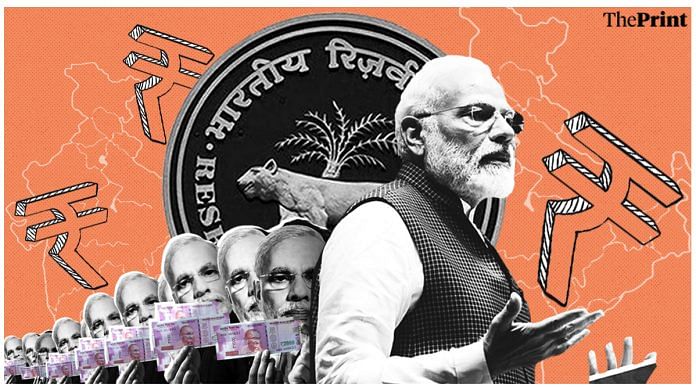The Reserve Bank of India will transfer a record Rs 1.76 lakh crore dividend and surplus reserves to the Narendra Modi government. Experts believe the infusion can help the government rev up its spending to boost the economy and contain the fiscal deficit too.
ThePrint asks: Does slowdown justify Modi govt dipping into RBI excess reserves or is it just a band-aid?
If the govt doesn’t abide by austerity measures, then there is no point of RBI’s record surplus transfer
 Abhijit Sen
Abhijit Sen
Former Member of the Planning Commission
On whether it is justified for the Modi government to dip into the RBI excess reserves or if the move is just a band-aid, a short-term measure, it is important to note that there is actually a slowdown, which requires a fiscal stimulus. The fiscal stimulus is missing as the budget’s tax assumptions were widely seen to be off because of a 1 per cent shortfall in actual 2018-19 taxes.
Former RBI governor Bimal Jalan’s Economic Capital Framework report comes as a shot in the arm because the goals set in the Union Budget might be more realisable now after the fiscal stimulus. However, all of this is dependent on what the government does with the money and how it utilises it. As far as a band-aid for the economy is concerned, the government should also note that some austerity measures are good and it should abide by them. If these are not kept in mind, then there is no point of this record surplus transfer.
Many look at the RBI’s move negatively, and think that the Centre is eating into the RBI’s savings. However, this is not strictly true. At worst this may cause, the RBI to print more notes than usual, thus the govt monetising the deficit to some extent.
This fiscal support with accommodative monetary policy could ward off India’s near-term economic challenges
 Soumya Kanti Ghosh
Soumya Kanti Ghosh
Group Chief Economic Adviser, SBI
The Jalan committee’s review of the RBI’s Economic Capital Framework shows it had been working on the dividend transfer aspect of the central bank for quite some time, and after a lot of deliberation, the members have recommended the guidelines for dividend transfer.
In fact, their report has clearly ruled out dipping into unrealised gains for capital transfer, which I believe is a sagacious decision. In the Union Budget, the RBI dividend expectations were set close to Rs 900 billion (Rs 90,000 crore). Taking this into account, the excess transfer is only around Rs 576 billion (Rs 57,600 crore). This is just around 0.3 per cent of India’s GDP.
We believe this fiscal support together with accommodative monetary policy could play a perfect foil to ward off the near-term challenges on the growth front. For jumpstarting the economy, action points are being already announced and the Modi government is working towards reviving the stressed sectors.
These steps will bear fruit in some time. But with the global growth facing continuous challenges, India might need more of policy interventions in the immediate future. But, for now, financial markets should rejoice at the fact that the RBI excess transfer will provide support to fiscal prudence that the government has steadfastly adhered to.
Also read: Amend the law to settle conflict over RBI’s surplus once and for all
At a time when banks are under pressure and rupee is getting weaker, govt has decided to gamble on economy
 Narendar Pani
Narendar Pani
Professor, National Institute of Advanced Studies
The RBI’s decision to transfer Rs 1.76 lakh crore of its surplus to the government will undoubtedly ease the burden of India’s fiscal deficit, which accounts for a quarter of the deficit projected in the Union Budget. While that does look very positive for the government’s finances, its effectiveness will be tested by other factors. A continuing slowdown of the economy will adversely affect the collection of both direct and indirect taxes. The transfer would then be absorbed into the black hole of a fiscal deficit without offering the government any leeway for fresh initiatives to deal with the economy.
What should cause greater concern — more than the reliance on this uncertain source of funding — is what the central bank’s measure does to the ability of the RBI to intervene effectively in protecting the rupee as well as stabilising the economy. The Jalan committee had recommended a Contingency Risk Buffer of between 6.5 per cent to 5.5 per cent of the RBI’s balance sheet. The central bank’s transfer now implies that it will be kept at the lower end of the buffer. At a time when the banks are under pressure and the rupee is showing signs of getting weaker, the Modi government has clearly decided to gamble.
Regardless of economic condition, there needs to be a clear reserve redistribution policy in RBI Act
 Radhika Pandey
Radhika Pandey
Fellow, NIPFP
Every country has some framework set for deciding how much surplus should be transferred from the central bank to the central government. This framework is enshrined in the central bank laws. In India’s case, the RBI Act allows the central bank to choose what proportion of reserves it transfers to the government. As a consequence of this legal provision, the RBI has accumulated reserves, which are more than what most countries’ central banks hold. In the absence of a clear guidance under the RBI Act, committees have been set up to assess the adequacy of provisioning made for reserves and to determine the quantum of transfers to be made to the central government. The annual transfer has always been a matter of contention between the government and the RBI.
The Jalan panel is a step towards coming up with a framework for reserves and surplus distribution. It has given its recommendations on the RBI’s Economic Capital Framework. The panel has recommended that the RBI’s economic capital should lie within the range of 24.5 per cent to 20 per cent. Regardless of the economic condition — whether there is an upturn in the economy or slowdown — the question of RBI’s economic capital and surplus distribution policy needs to be debated and settled so that there is certainty on its reserves distribution policy. Ideally, this should be provided for in the RBI Act.
Views are personal.
Also read: Why RBI Governor Shaktikanta Das has lent a Rs 1.76 lakh crore umbrella to Modi govt
RBI transferring surplus shouldn’t be seen as necessarily linked to the economic slowdown
 Arjun Jayadev
Arjun Jayadev
Professor of Economics at the School of Arts and Sciences at Azim Premji University
The news of the RBI transferring a surplus of more than Rs 50,000 crore should not be seen as necessarily linked to the economic slowdown. This debate has been going on for many months now but the RBI’s decision to transfer money to the Modi government has been implemented only at this juncture. What is at stake is really the relationship between the RBI and the central government and the degree to which, if at all, the perceived erasing of the central bank’s independence will have consequences for financial stability and market expectations.
With regard to the slowdown, it is probably useful for the government to have more resources, given the degree to which it is hemmed in by its own fiscal targets. Whether or not this move will help resolve the slowdown depends on the kind of cyclical and structural impediments our economy faces. My own sense is that there are structural impediments in terms of debt overhang and skewed patterns of growth that cannot simply be wished away. Having said that, there is a serious lack of demand. Export growth is tepid, consumption has slowed down and investment is yet to pick up. Inflation is well under control. But getting demand up in the macroeconomy — in ways that crowd in other expenditure — will be needed and to the extent that RBI’s move helps, may turn out to be for the best.
Contingency funding well within international benchmarks as long as proceeds are used for fiscal stimulus
 Abizer Diwanji
Abizer Diwanji
EY India Financial Services and Restructuring Leader
The RBI has accepted the Jalan committee’s recommendations to reduce its contingency fund to somewhere between 6.5 per cent to 5.5 per cent of its balance sheet as against 6.8 per cent and, therefore, released an incremental Rs 52,637 crore to the government’s kitty in addition to its annual dividend. The RBI’s transfer of Rs 1,76,600 crore means that the Modi government received an incremental Rs 86,000 crore.
At a time when the government is fighting to maintain fiscal deficit given the global slowdown, the need for fiscal stimulus Rs 86,000 could come to much use. However, the key to its effectiveness lies in where this is spent. Based on Nirmala Sitharaman’s announcement, if this money is utilised in compensating for the superrich tax reversal (Rs 12,000 crore) and immediate infusion of capital of the promised Rs 70,000 crores to banks for capital infusion, then this could boost economic growth.
Capital infusion to get banks out of PCA (prompt corrective action) will not be productive as that would only go towards filling the capital gap. Funds need to be given to those banks that have had a proven record of lending even in these times or providing the much-needed liquidity to NBFCs (non-banking finance companies) through the capital enhancement scheme. In conclusion, contingency funding seems well within international benchmarks as long as the proceeds are used for fiscal stimulus.
Also read: Nirmala Sitharaman gets new options to balance budget, thanks to RBI’s bonanza
RBI funds transfer simply reflects the perilous state of India’s public finance management
 Shankkar Aiyar
Shankkar Aiyar
Political Economy Analyst and Author of Aadhaar: A Biometric History of India’s 12 Digit Revolution & Accidental India
The RBI is the government’s banker. It is duty-bound to ensure that the government does not fail to meet its obligations. This transfer of resources from one repository to another is like bypass surgery to ensure systemic solvency. The transfer does not represent a systemic threat — at least, not immediately and if it does, it will fall on the government to do the needful.
A large part of the so-called windfall of Rs 1.76 lakh crore is already accounted for — Rs 28,000 crore was sanctioned in the last financial year as advance and Rs 90,000 crore has been penned down as expected transfers. That leaves the government with roughly Rs 58,000 crore. Contrast this buffer with the gaps confronting the government — of lower revenue growth, lower GST for which states would have to be compensated, rising demand for bank recapitalisation and packages for flood and drought-hit regions. Not to mention, the outstanding payments to creditors and PSEs.
Does the economic slowdown justify dipping into reserves? The issue is less about the slowdown and more about the state of the government finances. In the last 10 years, government spending, by both the Centre and states, has shot up from Rs 18 lakh crore to more than Rs 53 lakh crore. The RBI funds transfer simply reflects the perilous state of India’s public finance management.
By Revathi Krishnan and Taran Deol




Ms Latha Venkatesh has tweeted that it was Dr Arvind Subramanian’s idea in 2016 that the RBI should transfer four trillion out of its reserves to the government. So both the hunger for resources and the slowdown go back in time to the year of Demonetisation. Once the seed of a Bad idea is sown, just a matter of time before the weeds appear.
What makes you think it is a bad idea when every country does it in the world?
Who created the slowdown ? 2. Two tweets from @churumuri ( Shri Krishna Prasad ), to give a snapshot of the real economy, from two widely separated parts of the country. 10,000 small units from the Peenyi Industrial estate near Bangalore, in the ICU, 12,00,000 lac jobs at risk. 3. In Kashmir, no PDS supplies since 5th August, no work for daily labourers, no release of development funds to Panchayats, the Bakerwals ( our precious child Asifa ) near starvation, the unharvested pear crop beginning to rot. 3. Someone should be minding the store.